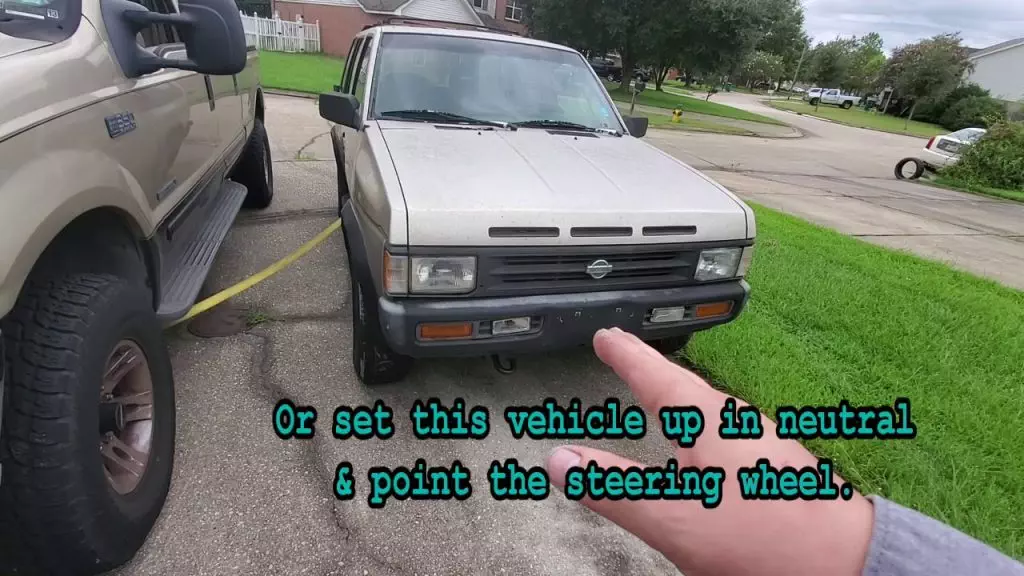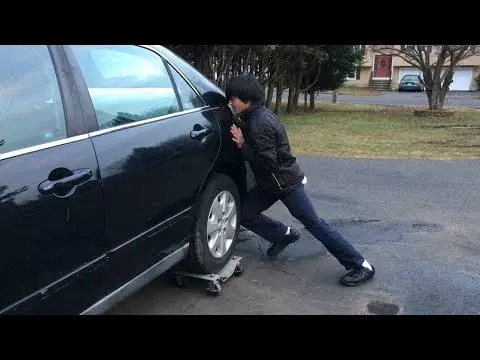Imagine this scenario: you find yourself standing in front of a car that seems determined to stay put. Its wheels are stubbornly refusing to budge, leaving you scratching your head in frustration. So, how exactly do you solve this dilemma? How can you move a car that simply refuses to move? Stick around as we unravel the mysteries and share some practical tips on how to tackle this common predicament. Spoiler alert: you won’t need superpowers or a magic wand to get that car moving!
Causes of a car not moving
When a car doesn’t move, there are several potential causes that could be contributing to the problem. Let’s take a look at some of the most common issues that can result in a car not moving.
Dead battery
One of the primary reasons for a car not moving is a dead battery. If the battery is completely drained, it will not have enough power to start the engine. This can occur if the lights or other electrical components were left on for an extended period or if the battery is old and needs to be replaced.
Transmission issue
Another possible cause is a transmission issue. The transmission plays a vital role in transferring power from the engine to the wheels, allowing the car to move. If there is a problem with the transmission, such as a worn clutch or a damaged gear, the car may not be able to engage or shift gears properly.
Faulty starter motor
A faulty starter motor is another common culprit when a car fails to move. The starter motor is responsible for initiating the engine’s combustion process. If the starter motor malfunctions and doesn’t provide the necessary power to crank the engine, the car won’t be able to start.
Fuel delivery problem
A car may also not move if there is a fuel delivery problem. Issues such as a clogged fuel filter or a malfunctioning fuel pump can prevent the engine from receiving an adequate fuel supply. Without enough fuel, the engine won’t be able to run, and the car will not move.
Spark plug or ignition coil issue
Faulty spark plugs or ignition coils can also result in a car not moving. Spark plugs generate the spark necessary to ignite the fuel mixture in the engine cylinders. If the spark plugs are worn out or there is an issue with the ignition coils, the engine may not start or run smoothly, leading to a car that won’t move.
Troubleshooting Steps
If your car is not moving, you can try some troubleshooting steps to identify and potentially resolve the issue. Here are some steps to consider:
Check the battery connections
Start by checking the battery connections. Ensure that they are clean and securely fastened. Loose or corroded connections can prevent the battery from supplying power to the electrical systems, including the starter motor.
Jumpstart the car
If you suspect that the battery is the problem, you can try jumpstarting the car. Use jumper cables and another vehicle with a functioning battery to provide the necessary boost. Allow the working vehicle to run for a few minutes before attempting to start your car.
Inspect the transmission
If the car still won’t move, it’s essential to inspect the transmission. Look for any signs of damage or leakage. If everything appears normal, you may want to consult a professional mechanic for a more thorough evaluation.
Test the starter motor
To determine if the starter motor is faulty, you can try tapping it gently with a hammer while someone else attempts to start the car. If the car starts, it’s an indication that the starter motor may need to be replaced.
Check fuel pump and filter
Inspect the fuel pump and filter for any signs of damage or blockage. If you suspect a problem, it’s advisable to have a professional check and potentially replace these components if necessary.
Inspect spark plugs and ignition coils
Finally, take a look at the spark plugs and ignition coils. Remove the spark plugs and inspect them for signs of wear or fouling. Check the ignition coils for any visible damage. If you notice any issues, it’s recommended to replace them with new components.

This image is property of i.ytimg.com.
Towing the car
In some cases, you may need to tow the car to a different location or a mechanic for further inspection and repairs. There are a few different methods for towing a car, each suited to different circumstances.
Using a tow truck
The most common and efficient way to tow a car is by using a tow truck. A tow truck is specifically designed for safely transporting vehicles. The car is elevated onto the tow truck’s bed or lifted by its wheels using a flatbed tow truck. This method is ideal for long distances or when the car is damaged.
Using a tow dolly
If your car has front-wheel drive and the rear wheels can roll freely, you can use a tow dolly. A tow dolly is a small trailer-like device that raises the front wheels of the car off the ground while allowing the rear wheels to remain on the road. However, it’s important to ensure that your car is configured correctly for this method.
Using a tow bar
A tow bar is another option for towing a car. It consists of a metal frame that attaches to the towing vehicle and connects to the front bumper or chassis of the car being towed. This method is commonly used for shorter distances and is suitable for cars that are all-wheel drive or have rear-wheel drive.
Pushing or rolling the car
If your car needs to be moved a short distance, you can consider pushing or rolling it. Here are a few methods for manual movement:
Pushing the car manually
The simplest method is to gather a group of people to manually push the car. Ensure that the car is in neutral, release the parking brake, and have everyone apply coordinated force to move the vehicle.
Using a vehicle to push
Another option is to have another car or a larger vehicle push the non-moving car. This method requires caution and coordination between drivers. It’s crucial to have a clear communication system in place, such as using walkie-talkies or hand signals.
Rolling the car downhill
If you are parked on an incline, you can try rolling the car downhill to initiate movement. Release the parking brake gradually and allow the car’s weight to begin rolling. Be mindful of your surroundings and ensure you have enough space to stop the car safely.
This image is property of qph.cf2.quoracdn.net.
Seeking professional assistance
If you have attempted troubleshooting steps but the car still refuses to move, it may be time to seek professional assistance. Here are a couple of options to consider:
Calling a roadside assistance service
If you have access to a roadside assistance service, such as through your insurance provider or a dedicated service provider, you can call for help. They can dispatch a professional to assess the situation and potentially provide a solution on the spot.
Contacting a mechanic or garage
If you can’t access a roadside assistance service, contacting a mechanic or garage is another viable option. They have the knowledge and expertise to diagnose and repair issues that prevent your car from moving. Be sure to provide them with detailed information about the problem so they can efficiently assist you.
Safety precautions
When dealing with a non-moving car, it’s essential to prioritize safety. Here are some key safety precautions to keep in mind:
Wear safety gear
When attempting any repairs or movement, wear appropriate safety gear, such as gloves and protective eyewear. This ensures your safety in case of accidents or mishaps.
Use proper equipment
If you are towing or pushing the car, use the appropriate equipment and follow the manufacturer’s instructions carefully. Improper equipment or incorrect use can lead to accidents or damage to the vehicles involved.
Follow traffic regulations
When moving a non-moving car, ensure that you follow all traffic regulations. This includes using hazard lights, obeying speed limits, and signaling your intentions to other drivers.
Exercise caution when pushing or towing
Take caution when pushing or towing a non-moving car. Be aware of your surroundings, and only attempt these methods if you are confident in your abilities. If you are unsure, seek professional assistance instead.

This image is property of i.ytimg.com.
Preparing for future incidents
Dealing with a car that doesn’t move can be frustrating, but it’s essential to be prepared for future incidents. Here are a few ways to ensure you are better equipped to handle potential issues:
Maintain your car regularly
Regular maintenance is crucial for keeping your car in good condition and minimizing the risk of breakdowns. Follow the manufacturer’s recommended maintenance schedule for services such as oil changes, tire rotations, and inspections.
Carry emergency tools and supplies
Always keep a basic toolkit in your car, including items such as jumper cables, a flashlight, a tire pressure gauge, and a spare tire. Additionally, consider having emergency supplies such as water, non-perishable food, and a first aid kit in case of extended breakdowns.
Learn basic car repair skills
Acquiring basic car repair skills can come in handy when dealing with minor issues or emergencies. Consider taking a class or watching instructional videos to learn how to perform simple repairs, such as changing a flat tire or replacing a fuse.
Conclusion
A car that doesn’t move can be frustrating and inconvenient, but by understanding the potential causes and following the troubleshooting steps outlined above, you can often identify and resolve the issue. Remember to prioritize safety throughout the process and seek professional assistance when necessary. By being prepared and proactive, you can minimize the impact of a non-moving car and handle future incidents with confidence.

This image is property of www.jerseycash4cars.com.